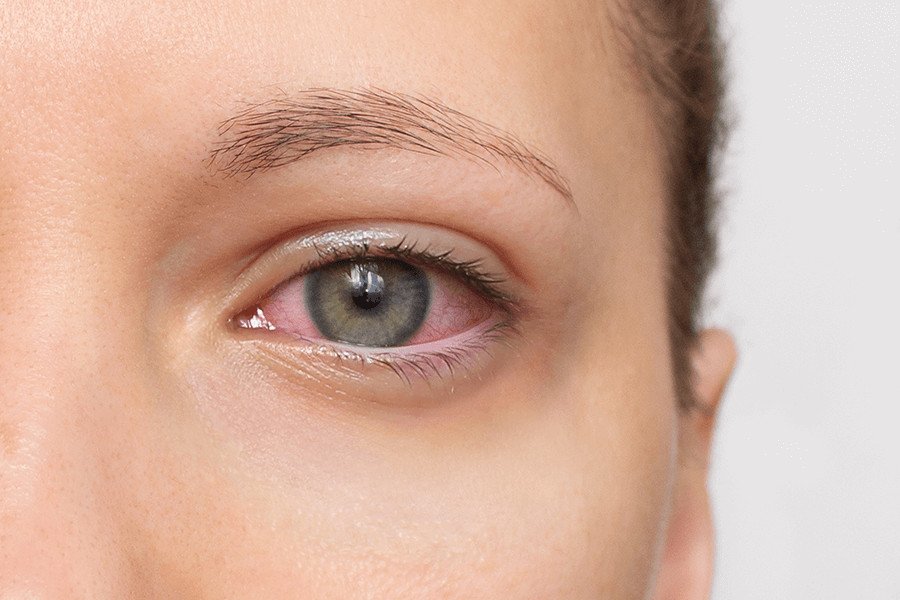
Dry eye is a condition characterized by a persistent sensation of irritation or discomfort in the eyes, often stemming from the eye’s inability to produce an adequate or balanced tear film.
The tear film plays a vital role in protecting and maintaining the health of the eye’s surface and is composed of three distinct layers: an inner mucus layer, a central aqueous (watery) layer, and an outer lipid (oily) layer. With each blink, this tear film is evenly distributed across the eye’s surface, ensuring smoothness and clarity. However, when tear production is insufficient or the composition of the tear film is compromised, dry eye symptoms may arise.
If you are experiencing stinging, burning, or other symptoms of discomfort, it is advisable to schedule a comprehensive eye examination with Dr. Benaim, who can diagnose the condition and offer tailored treatment recommendations for relief.
Accordion Content

There are several factors that can contribute to dry eye, including:
At Dr. Monroe Benaim’s office, diagnosing dry eye involves a comprehensive evaluation of your eye health. Dr. Benaim will:
This thorough approach helps identify the cause of your dry eye and guides treatment decisions.
At Dr. Benaim’s practice, we offer a range of treatments tailored to each patient’s specific needs, including:
With the right treatment, most patients experience significant relief from dry eye symptoms. Dr. Benaim’s personalized treatment plans, combined with innovative technology like radiofrequency (RF) and Intense Pulsed Light (IPL), offer lasting improvements in tear production and overall eye health. Early intervention and proper care can prevent further complications, such as corneal damage, and help you regain comfort in your daily activities.
At Dr. Benaim’s office, our goal is to ensure that every patient achieves long-term relief from dry eye and enjoys improved vision quality. Schedule an appointment today to take the first step toward clearer, more comfortable eyes!
Dry eyes may start as a minor discomfort, but the condition can escalate into a significant health concern if left untreated. Chronic dry eye disease can damage the cornea, increase susceptibility to eye infections and negatively impact daily life by causing persistent irritation and blurry vision. Long-term dryness can also interfere with your ability to focus or perform activities like reading and driving. If dry eye symptoms persist or worsen, it’s essential to seek professional help to determine the underlying cause and receive appropriate care. At Benaim Eye and Aesthetics, our specialists can provide a customized plan to address the issue and protect your eye health.
Effective treatment for dry eyes depends on the severity and cause of the condition. Options range from over-the-counter artificial tears to prescription eye drops that reduce inflammation and stimulate tear production. For individuals with more severe cases of dry eye disease, advanced therapies such as intense pulsed light (IPL) treatment or LipiFlow, which targets blocked oil glands, may be necessary. Sometimes, lifestyle adjustments like taking breaks during screen use or using humidifiers can also help. For a personalized solution, Benaim Eye and Aesthetics offers comprehensive evaluations and advanced treatments to manage dry eyes effectively.
The healing process for dry eyes depends on factors like the cause of the condition, the treatment being used and the individual’s adherence to care. Mild cases of dry eyes caused by temporary factors may improve within days with artificial tears. Chronic dry eye disease often requires long-term management, with some patients noticing relief after weeks or months of consistent treatment. Healing timelines vary widely, so it’s critical to work with a specialist who can guide you to achieving lasting comfort and relief.
When over-the-counter artificial tears fail to relieve dry eye symptoms, the underlying issue may require advanced care. Persistent dryness can stem from inflammation, oil gland dysfunction or an autoimmune condition such as Sjögren’s syndrome. Alternative treatments include prescription medications like cyclosporine (Restasis) or lifitegrast (Xiidra), thermal therapies like LipiFlow or even procedures to retain natural tears, such as punctal plugs. A thorough examination by the team at Benaim Eye and Aesthetics can identify the cause of your condition and provide tailored solutions.
Proper hydration plays a key role in maintaining healthy tear production, as dehydration can exacerbate dryness in the eyes. Drinking plenty of water each day can support overall eye health and reduce mild dry eye symptoms. However, for chronic dry eye disease, staying hydrated is just one piece of the puzzle. Comprehensive treatments may still be required to manage more severe conditions.
Vitamin A is essential for maintaining a healthy corneal surface and tear production. A deficiency in this nutrient is a known cause of dry eyes and can lead to severe vision problems if unaddressed. Similarly, insufficient omega-3 fatty acids in your diet can reduce tear quality, making it harder for your eyes to retain moisture. Addressing these deficiencies through diet or supplementation can help alleviate dry eye symptoms.
For immediate relief from dry eyes, using preservative-free artificial tears can quickly restore moisture to the eyes. Applying a warm compress to the eyelids can also help stimulate the oil glands, improving tear stability. If discomfort persists or worsens, it’s essential to seek a professional evaluation to identify the root cause and explore more advanced treatments.
Several conditions mimic the symptoms of dry eyes, including eye allergies, blepharitis (eyelid inflammation) and even contact lens-related irritation. Autoimmune diseases like Sjögren’s syndrome can also present with similar dryness symptoms. A professional diagnosis with Benaim Eye and Aesthetics is vital to ensure you’re treating the correct condition and avoiding unnecessary complications.
While Vaseline can be applied to the skin around the eyes to lock in moisture, it is not an appropriate treatment for dry eye disease. Petroleum jelly is not formulated for use directly in the eyes and could lead to irritation or infection. Ophthalmic-grade lubricants are safer and more effective for relieving dry eye symptoms.
Ophthalmologists recommend a range of treatments depending on the severity of dry eyes. These may include artificial tears, prescription drops to reduce inflammation and devices like LipiFlow to unblock oil glands. For severe cases, advanced treatments such as autologous serum tears or light-based therapies may be necessary. At Benaim Eye and Aesthetics, a customized approach ensures patients receive the most effective care for their condition.
Preservative-free artificial tears, especially those containing hyaluronic acid, are considered the best natural eye lubricants. These drops closely mimic the eye’s natural tear film, providing soothing relief without the risk of irritation from preservatives.
Innovative therapies for dry eye disease include biologic eye drops and advanced technologies targeting meibomian gland dysfunction. Treatments such as IPL therapy or TearCare are gaining popularity for addressing underlying causes of dryness. These leading-edge solutions offer new hope for patients with chronic or treatment-resistant cases.
For individuals with chronic dry eye symptoms, daily use of preservative-free artificial tears can provide ongoing relief. However, it’s important not to overuse eye drops containing preservatives, as they can worsen irritation over time. A professional evaluation with Benaim Eye and Aesthetics can determine the safest and most effective routine for managing your dry eyes.
Excessive use of artificial tears, particularly those with preservatives, can irritate the eyes and lead to dependency. Preservative-free drops are a safer option for frequent use. Following an ophthalmologist’s guidance ensures you’re using eye drops effectively without overdoing it.
The best eye drops for dry eye disease depend on the severity and cause of the condition. Preservative-free artificial tears are ideal for daily use, while prescription drops like Restasis, Xiidra or Cequa can treat underlying inflammation. Gel-based drops are recommended for nighttime use to provide longer-lasting relief.
Dry eye disease varies in severity, from mild discomfort to severe complications like corneal ulcers or infections. Chronic dry eye can impact vision and quality of life, making early diagnosis and treatment essential.
A major consequence of untreated dry eye disease is corneal damage, which can lead to permanent vision loss. Chronic dryness also increases the risk of eye infections and significantly impacts daily activities like reading or driving.
Vitamin A deficiency is a well-known cause of dry eye disease, as this nutrient is vital for tear production and maintaining the corneal surface.
Complications of dry eyes include corneal ulcers, infections and scarring, all of which can impair vision. Chronic dryness can also exacerbate discomfort and decrease quality of life.
Risk factors for dry eye syndrome include aging, hormonal changes, autoimmune diseases, prolonged screen time and certain medications like antihistamines or diuretics.
While dry eye is a common symptom of Sjögren’s syndrome, they are not the same. Sjögren’s is an autoimmune disease that affects moisture-producing glands in the body, causing dry eyes and mouth.